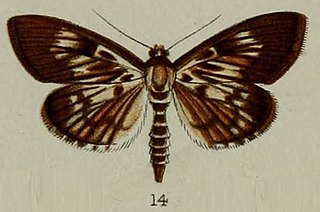
Niphanda cymbia, the pointed Pierrot, is a small butterfly found in northern India, Burma and northern Borneo that belongs to the lycaenids or blues family.
Phaedropsis domingalis is a species of moth in the family Crambidae. It was described by William Schaus in 1920. It is found in the Dominican Republic.
Phaedropsis maritzalis is a species of moth in the family Crambidae. It was described by William Schaus in 1920. It has been found in Guatemala, Honduras and Venezuela.
Pilocrocis bastalis is a moth in the family Crambidae. It was described by William Schaus in 1920. It is found in Peru.
Pilocrocis cyranonalis is a moth in the family Crambidae. It was described by William Schaus in 1920. It is found in Guatemala.
Pilocrocis guianalis is a moth in the family Crambidae. It was described by William Schaus in 1920. It is found in French Guiana.

Pilocrocis sororalis is a moth in the family Crambidae. It was described by William Schaus in 1920. It is found in Panama and Guatemala.
Polygrammodes herminealis is a moth in the family Crambidae. It was described by Schaus in 1920. It is found in Brazil (Paraná).
Polygrammodes supremalis is a moth in the family Crambidae. It was described by William Schaus in 1920. It is found in Paraná, Brazil.
Polygrammodes dubialis is a moth in the family Crambidae. It was described by Schaus in 1924. It is found in Brazil.
Sinomphisa junctilinealis is a moth in the family Crambidae. It is found in Sierra Leone and Uganda.
Steniodes dominicalis is a moth in the family Crambidae. It was described by Schaus in 1924. It is found on Dominica.
Stenorista fortunata is a moth in the family Crambidae. It was described by Schaus in 1912. It is found in Costa Rica.

Syllepte picalis is a moth in the family Crambidae. It was described by George Hampson in 1898. It is found in Meghalaya, India.
Syllepte birdalis is a moth in the family Crambidae. It was described by William Schaus in 1920. It is found in Venezuela.
Syllepte anchuralis is a moth in the family Crambidae. It was described by William Schaus in 1920. It is found in Guatemala.
Syllepte nebulalis is a moth in the family Crambidae. It was described by William Schaus in 1920. It is found in Peru.
Tyspanodes piuralis is a moth in the family Crambidae. It was described by Schaus in 1920. It is found in Peru.
Udea endotrichialis is a moth in the family Crambidae. It was described by George Hampson in 1918. It is found in Taiwan.
Udea poasalis is a moth in the family Crambidae. It was described by Schaus in 1912. It is found in Costa Rica.


